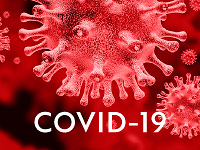Clinical and biological data suggest that the occurrence of a cytokine storm may be crucial in determining the clinical features and severity of COVID-19, with interleukin-6 playing a major role; thus, inhibiting its activity by blocking its binding to the specific receptor could be useful [1].
Here we report on the use of tocilizumab (RoActemra©, Roche), a humanised anti-human interleukine-6 receptor antibody, in 20 hospitalised patients with SARS-CoV-2 infection confirmed by reverse transcriptase-polymerase chain reaction assay and severe pneumonia (PaO2/FiO2 ratio < 300) undergoing high flow oxygen or noninvasive positive-pressure ventilation with interleukin-6 serum levels higher than 20 pg/ml; mechanically ventilated patients were excluded. In these patients, tocilizumab 8 mg/kg intravenously (maximum 800 mg) were added to standard treatment (hydroxychloroquine, prophylactic enoxaparin, oxygen, and nutritional support); a further identical dose was administered 12 h later if no significant amelioration could be found. The drug was prescribed as off-label, and local Ethics Committee approval and informed consent were obtained for each patient. Patients were followed until discharge or death; 1 patient is still hospitalised.
The age range was 32 to 78 years (median 60 years) (Table I). At baseline, 18 patients were receiving noninvasive positive-pressure ventilation, and 2 patients recieved high-flow oxygen; median PaO2/FiO2 ratio was 137 (range: 101–210). The median duration of symptoms before tocilizumab therapy was 10.5 days (range: 3–21 days), and tocilizumab was administered a median of 2.5 days after admission (range: 0–13). Four patients underwent mechanical ventilation during follow-up: 1 patient died, 2 patients were extubated and discharged, and 1 patient was extubated but still in intensive care due to intervening septic complications. The time to cessation of high-flow oxygen or noninvasive positive-pressure ventilation was 5.5 days, and the median duration of hospitalisation was 15 days (range: 7–52 days). The mortality rate was 5%, and there were no clinical and laboratory differences between patients who required or did not require mechanical ventilation during hospitalisation. No adverse drug reaction was reported.
Table I
Demographic and clinical characteristics of the patients
It is still a matter of debate whether the clinical course of COVID-19 is different in patients with rheumatic disease or in those undergoing a disease-modifying treatment [2, 3]. A previous report from China showed that tocilizumab could be an effective treatment, able to reduce the mortality of COVID-19 patients [4]. Data from our preliminary report seems to confirm such an effect and compare well with those from other studies: the mortality rate was 14% in severe Chinese patients [5], 22% in patients treated with lopinavir-ritonavir [6], and 13% in patients treated with remdesivir [7], while the aggregated data of death and intubation was 20% (4 patients) in our series, and 32.3% in patients treated with hydroxychloroquine alone [8]. Adding Tocilizumab to standard treatment in patients with severe COVID-19 could therefore be useful.
Our study has significant shortcomings: mainly the small size of the treated cohort and the lack of a control (possibly randomised) group, which limit the interpretation of the results.
These preliminary data therefore need confirmation in larger populations by case-control studies and mainly by randomised studies.



